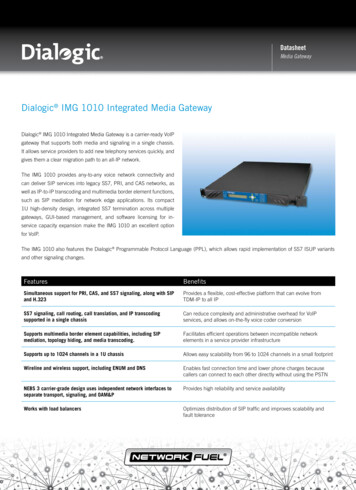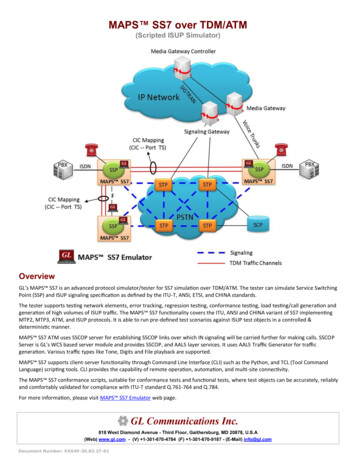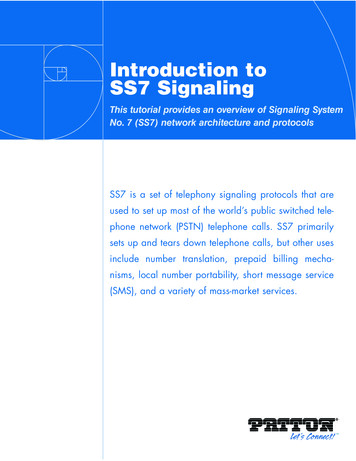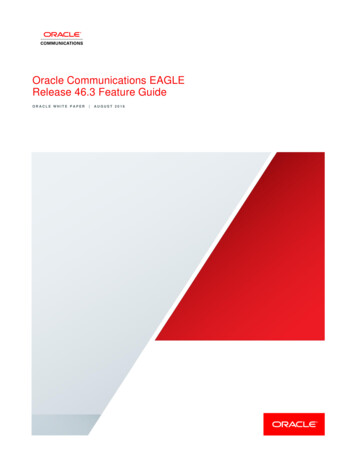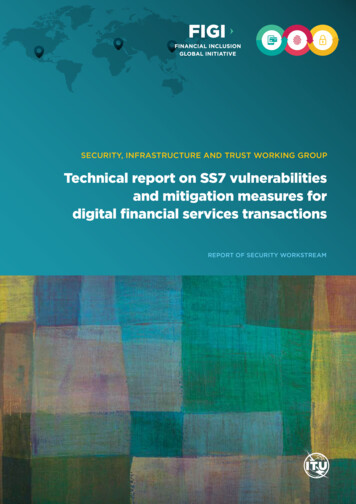
Transcription
SECURITY, INFRASTRUCTURE AND TRUST WORKING GROUPTechnical report on SS7 vulnerabilitiesand mitigation measures fordigital financial services transactionsREPORT OF SECURITY WORKSTREAMTechnical report on SS7 vulnerabilities and mitigation measures for digital financial services transactions a
b Technical report on SS7 vulnerabilities and mitigation measures for digital financial services transactions
SECURITY, INFRASTRUCTURE AND TRUST WORKING GROUPTechnical report on SS7 vulnerabilitiesand mitigation measures fordigital financial services transactions
2 Technical report on SS7 vulnerabilities and mitigation measures for digital financial services transactionsDISCLAIMERThe Financial Inclusion Global Initiative (FIGI) is a three-year program implemented in partnership by the World Bank Group (WBG), the Committee onPayments and Market Infrastructures (CPMI), and the International Telecommunication Union (ITU) funded by the Bill & Melinda Gates Foundation (BMGF)to support and accelerate the implementation of country-led reform actionsto meet national financial inclusion targets, and ultimately the global ‘Universal Financial Access 2020’ goal. FIGI funds national implementations in threecountries—China, Egypt and Mexico; supports working groups to tackle threesets of outstanding challenges for reaching universal financial access: (1) theElectronic Payment Acceptance Working Group (led by the WBG), (2) TheDigital ID for Financial Services Working Group (led by the WBG), and (3)The Security, Infrastructure and Trust Working Group (led by the ITU); andhosts three annual symposia to gather national authorities, the private sector,and the engaged public on relevant topics and to share emerging insights fromthe working groups and country programs.This report is a product of the FIGI Security, Infrastructure and Trust WorkingGroup, led by the International Telecommunication Union.The findings, interpretations, and conclusions expressed in this work do notnecessarily reflect the views of the Financial Inclusion Global Initiative partnersincluding the Committee on Payments and Market Infrastructures, the Bill &Melinda Gates Foundation, the International Telecommunication Union, or theWorld Bank (including its Board of Executive Directors or the governments theyrepresent). The mention of specific companies or of certain manufacturers’products does not imply that they are endorsed or recommended by ITU in preference to others of a similar nature that are not mentioned. Errors and omissionsexcepted, the names of proprietary products are distinguished by initial capitalletters. The FIGI partners do not guarantee the accuracy of the data included inthis work. The boundaries, colours, denominations, and other information shownon any map in this work do not imply any judgment on the part of the FIGI partners concerning the legal status of any country, territory, city or area or of itsauthorities or the endorsement or acceptance of such boundaries. ITU 2020Some rights reserved. This work is licensed to the public through a Creative CommonsAttribution-Non-Commercial-Share Alike 3.0 IGO license (CC BY-NC-SA 3.0 IGO).Under the terms of this licence, you may copy, redistribute and adapt the work for non-commercial purposes, provided the work is appropriately cited. In any use of this work, there should beno suggestion that ITU or other FIGI partners endorse any specific organization, products or services. The unauthorized use of the ITU and other FIGI partners’ names or logos is not permitted.If you adapt the work, then you must license your work under the same or equivalent CreativeCommons licence. If you create a translation of this work, you should add the following disclaimeralong with the suggested citation: “This translation was not created by the International Telecommunication Union (ITU). ITU is not responsible for the content or accuracy of this translation. Theoriginal English edition shall be the binding and authentic edition”. For more information, pleasevisit igo/
About this reportThis report was written by Assaf Klinger with special thanks to Dr. Leon Perlman forhis helpful support and contribution and the members of the Security, Infrastructure and Trust Working Group for their comments and feedback. Vijay Mauree, ITUprovided overall guidance for this report.For queries regarding the report, please contact, Vijay Mauree at ITU (email: tsbfigisit@itu.int)Technical report on SS7 vulnerabilities and mitigation measures for digital financial services transactions 3
ContentsExecutive Summary. . . . . . . . . . . . . . . . . . . . . . . . . . . . . . . . . . . . . . . . . . . . . . . . . . . . . . . . . . . . 7Abbreviations and acronyms. . . . . . . . . . . . . . . . . . . . . . . . . . . . . . . . . . . . . . . . . . . . . . . . . . . . 81 Introduction. . . . . . . . . . . . . . . . . . . . . . . . . . . . . . . . . . . . . . . . . . . . . . . . . . . . . . . . . . . . . . . 92 Impact of telecom vulnerabilities on DFS . . . . . . . . . . . . . . . . . . . . . . . . . . . . . . . . . . . . 92.1 Over the counter cash fraud. . . . . . . . . . . . . . . . . . . . . . . . . . . . . . . . . . . . . . . . . . . . . 92.2 Account takeover. . . . . . . . . . . . . . . . . . . . . . . . . . . . . . . . . . . . . . . . . . . . . . . . . . . . . . 102.3 Social engineering. . . . . . . . . . . . . . . . . . . . . . . . . . . . . . . . . . . . . . . . . . . . . . . . . . . . . 103 Telecom vulnerabilities and attack surfaces . . . . . . . . . . . . . . . . . . . . . . . . . . . . . . . . . 104 Common types of telecom attacks . . . . . . . . . . . . . . . . . . . . . . . . . . . . . . . . . . . . . . . . . . 115 The commonality of telecom attacks . . . . . . . . . . . . . . . . . . . . . . . . . . . . . . . . . . . . . . . 126 The challenge. . . . . . . . . . . . . . . . . . . . . . . . . . . . . . . . . . . . . . . . . . . . . . . . . . . . . . . . . . . . . 127 Misconception: Isn’t it hard to attack the telco? Governments do that. . . . . . . . . 138 The cellular attack kill chain. . . . . . . . . . . . . . . . . . . . . . . . . . . . . . . . . . . . . . . . . . . . . . . . 149 Examples of attacks on DFS infrastructure. . . . . . . . . . . . . . . . . . . . . . . . . . . . . . . . . . 149.1 SMS OTP interception. . . . . . . . . . . . . . . . . . . . . . . . . . . . . . . . . . . . . . . . . . . . . . . . . . 149.2 Social engineering of sensitive credentials using USSD. . . . . . . . . . . . . . . . . . . . 159.3 Denial of service attacks . . . . . . . . . . . . . . . . . . . . . . . . . . . . . . . . . . . . . . . . . . . . . . . 169.4 SIM card swap. . . . . . . . . . . . . . . . . . . . . . . . . . . . . . . . . . . . . . . . . . . . . . . . . . . . . . . . . 169.5 SIM card recycle. . . . . . . . . . . . . . . . . . . . . . . . . . . . . . . . . . . . . . . . . . . . . . . . . . . . . . . 1610 Mitigation strategies for mobile operators. . . . . . . . . . . . . . . . . . . . . . . . . . . . . . . . . . . 1610.1 FS.11: SS7 Interconnect Security Monitoring Guidelines. . . . . . . . . . . . . . . . . . . . 1610.2 FS.07: SS7 and SIGTRAN Network Security. . . . . . . . . . . . . . . . . . . . . . . . . . . . . . . 1710.3 IR.82: Security SS7 implementation on SS7 network guidelines . . . . . . . . . . . . . 1710.4 IR.88: LTE and EPC roaming guidelines. . . . . . . . . . . . . . . . . . . . . . . . . . . . . . . . . . . 1710.5 Mitigations in GSMA: documents vs common telecom attacks. . . . . . . . . . . . . . 1711 Implementation of mitigation among mobile operators . . . . . . . . . . . . . . . . . . . . . . 174 Technical report on SS7 vulnerabilities and mitigation measures for digital financial services transactions
12 Mitigation strategies for DFS providers . . . . . . . . . . . . . . . . . . . . . . . . . . . . . . . . . . . . . 1812.1 Detecting and mitigating account take over using intercepted OTP SMS. . . . 1812.2 Detecting and mitigating social engineering attacks with MT-USSD. . . . . . . . 1912.3 Detecting and mitigating interception of MO-USSD transactions. . . . . . . . . . . 1912.4 Detecting and mitigating unauthorized SIM card swap. . . . . . . . . . . . . . . . . . . . 1912.5 Detecting, preventing and mitigating SIM card recycle. . . . . . . . . . . . . . . . . . . . 2012.6 Embedding data within the user’s phone for authentication. . . . . . . . . . . . . . . 2012.7 Regulatory Activities. . . . . . . . . . . . . . . . . . . . . . . . . . . . . . . . . . . . . . . . . . . . . . . . . . . 2013 Conclusions and recommendations. . . . . . . . . . . . . . . . . . . . . . . . . . . . . . . . . . . . . . . . . 2113.1 Conclusions. . . . . . . . . . . . . . . . . . . . . . . . . . . . . . . . . . . . . . . . . . . . . . . . . . . . . . . . . . . . 2113.2 Recommendations. . . . . . . . . . . . . . . . . . . . . . . . . . . . . . . . . . . . . . . . . . . . . . . . . . . . . 21Annex A Technical description of SS7 and diameter. . . . . . . . . . . . . . . . . . . . . . . . . . . . . 22A.1 The SS7 protocol stack. . . . . . . . . . . . . . . . . . . . . . . . . . . . . . . . . . . . . . . . . . . . . . . . . 22A.2 The diameter protocol stack. . . . . . . . . . . . . . . . . . . . . . . . . . . . . . . . . . . . . . . . . . . . 22A.3 EPC protocol stack. . . . . . . . . . . . . . . . . . . . . . . . . . . . . . . . . . . . . . . . . . . . . . . . . . . . 23A.4 Support of voice services and SMS. . . . . . . . . . . . . . . . . . . . . . . . . . . . . . . . . . . . . . 24Annex B Template for a model MOU between a telecommunications regulatorand central bank related to DFS security. . . . . . . . . . . . . . . . . . . . . . . . . . . . . . . 26Technical report on SS7 vulnerabilities and mitigation measures for digital financial services transactions 5
Executive SummaryThe world of digital financial services (DFS) relies heavily on the underlying telecommunications infrastructureto enable users to send and receive money. In mostdeveloping countries where DFS is popular, most of theend-users do not have reliable and accessible means toconnect to Internet and thus rely heavily on the mobilecommunications infrastructure. The communicationchannels with which the end-user communicates withthe DFS provider are mostly Unstructured Supplementary Service Data (USSD), Short Messaging Service(SMS). USSD and SMS have long been known as “broken” and have many published vulnerabilities, someover 20 years old, which enables attackers to commitfraud and steal funds.The core issue that inhibits the mitigation of thesevulnerabilities is a misalignment of interests and misplaced liability between the telecom and the financialregulators. ITU and GSMA have long ago publishedguidelines and advisories to telecom operators (telco)on how to mitigate many of these vulnerabilities; however, the implementation rate of these mitigation measures is extremely low. According to surveys performedby this working group and the European Union Agencyfor Network and Information Security (ENISA), lessthan 30% of the telcos in the European Union (EU) andless than 0.5% of telcos in developing countries haveimplemented these mitigation strategies. This low rateof implementation is attributed to lack of awarenessto the existence of these vulnerabilities and the prohibitive cost set on the telcos to implement mitigationmeasures. Since the telcos are not liable in cases of DFSfraud, there is no financial incentive for the telcos tomitigate these telecom vulnerabilities.In order to advance the issue and mitigate many ofthese vulnerabilities, the working group recommendsthe following: Educate telecom and financial services regulatorson the vulnerabilities that plague the “DFS over telecom” ecosystem; Telecom and financial services regulators shouldimplement regulation that puts the liability whereit should be and forces the telcos to put mitigationmeasures in place; Telecom and financial services regulators shouldensure signalling security is covered in the legal framework in terms of reporting incidents and adoptingminimum security requirements; Telecom regulators are encouraged to establish baseline security measures for each category (3G/4G/5G)which should be implemented by telecom operatorsto ensure a more secure interconnection environment. ITU-T Study Group 11 could develop technicalguidelines for the baseline security measures; Create dialogue between the DFS providers and telecom regulators with the telecom security industry, bymeans of round tables to expose the DFS providersand regulators to the existing mitigation solutionsalready in the market and create an incentive for theindustry to develop more solutions; Incentivize both the telcos, DFS providers and industry to work together and implement solutions, byeither levying fines or providing grants, to build amore secure DFS ecosystem.Technical report on SS7 vulnerabilities and mitigation measures for digital financial services transactions 7
Abbreviations and acronymsBTSBase Transceiver Station for 2G/3G also know as cell towerCISOChief Information Security OfficerDFSDigital Financial ServiceeNodeBBase station for LTE a.k.a cell tower (LTE radio access element)ENISAEuropean Union Agency for Network and Information SecurityGTPGPRS Tunnelling ProtocolGSMAGSM AssociationHLR & VLR Home / Visitor Location Register, the central database that holds the telco’ssubscriber’s information, both native and roaming subscribers.IMEI International Mobile Equipment Identity; An identifier used by the telecomnetwork to uniquely identify a UE.IMSI & TMSI International Mobile Subscriber Identity; The mobile subscriber unique identifier,used internally in the telecom network.LTE Long Term Evolution, the fourth generation of cellular networks more commonlyknown as 4GMAP Mobile Application Part, an SS7 protocol that defines the signalling requiredfor mobile, e.g. roaming, calling, SMS etc.MO-SMSMobile Originated SMS, an SMS sent from the UE to the network.MO-USSDMobile Originated USSD transaction, a USSD transaction initiated by the UE.MSISDNMobile Station International Subscriber Directory NumberMT-SMSMobile Terminated SMS, an SMS sent from the network to the UE.MT-USSD Mobile Terminated USSD transaction, a USSD transaction initiated by the mobilenetwork to a specific UEMOUMemorandum of UnderstandingOTPOne Time Password.POPPost Office protocolPINPersonal Identification NumberSMSShort Messaging ServiceSS7 Signalling System No. 7—The signalling protocol used for interconnection betweentelecom networks and between internal sub components of each telecom network(land and mobile networks alike)STKSim Tool KitTelcoTelecom OperatorUE User Equipment, the user’s end device, in our case the mobile phone (featureor smart)USSD8Unstructured Supplementary Service Data Technical report on SS7 vulnerabilities and mitigation measures for digital financial services transactions
Technical report on SS7 vulnerabilitiesand mitigation measures fordigital financial services transactions1 INTRODUCTIONThe world of Digital Financial Services (DFS) is basedmostly on telecom, since in most countries where DFS ispopular, most of the end-users do not have reliable andaccessible means to connect to the internet, DFS hasadopted telecom as its main bearer. Due to the dominance of feature phones among users in developingeconomies, which comprise the majority of DFS endusers, the communication channels in which the enduser communicates with the DFS provider are mostlyUnstructured Supplementary Service Data (USSD),Short Messaging Service (SMS) and Sim Tool Kit (STK).Moreover, today the signalling network is not isolated,and this allows an intruder to exploit its flaws and intercept calls and SMSs, bypass billing, steal money frommobile accounts, or affect mobile network communications even in developed countries.USSD and SMS as means of communication havelong been known as susceptible to attack and havemany published vulnerabilities. Exploiting these vulnerabilities enables attackers to commit fraud andsteal funds from unsuspecting victims, who in in mostcases are unaware their account is being compromisedor hacked.This document surveys telecom vulnerabilities andtheir impact on digital financial services, both on theend user’s side and the service provider’s side. Thisdocument helps DFS providers understand the telecomvulnerability situation and create mitigation strategiesto safeguard their clients.2 I MPACT OF TELECOM VULNERABILITIESON DFSTelecom vulnerabilities enable criminals to perform various attacks that result in fraud to steal digital money;many of these attacks involve the attacker masquerading as the DFS provider to fraud the end-user or theattacker masquerading as the end-user to fraud theDFS provider. In all these cases, the attacker uses telecom vulnerabilities to pass authentication and performactions on compromised accounts. For example:2.1 Over the counter cash fraudIn this example, a fraudster walks up to a DFS agent(for example a seven-eleven branch) and requests cashwithdrawal from his account. The fraudster provides thevictim’s account number to the agent, when the agentinitiates the transaction, an SMS verification code is sentto the victim, however, this verification SMS is intercepted by the fraudster, and used to complete the fraudand steal the money.Technical report on SS7 vulnerabilities and mitigation measures for digital financial services transactions 9
2.2 Account takeoverIn this example, a fraudster uses USSD to takeover anaccount that does not belong to him. To perform thisattack, the fraudster first needs to spoof his victim’sphone number and dial the USSD code (this can bedone by over the air interception, explained further inSection 7). Once the fraudster initiates the USSD session with the DFS provider spoofing the victim’s phonenumber they can change the PIN code and add anotherphone number to the account. Once done, the fraudster performs another USSD session, this time with thenew phone number they added and uses the new PIN tologin to the account and transfer the money out.2.3 Social engineeringThere are many ways of social engineering, in this example; the fraudster uses USSD to perform social engineering that misleads the victim to give away the accountnumber and PIN. To perform this attack, the fraudsterimpersonates the DFS provider and sends a USSD message to the victim telling him that there is a pendingmoney transfer for his account, and in order to receiveit the victim enters his account number and PIN in theUSSD dialog. Once done, the attacker now has the victim’s account number and PIN and can take over thevictim’s account.103 T ELECOM VULNERABILITIES AND ATTACKSURFACESTelecom vulnerabilities can be exploited through twoattack surfaces, the SS7 network and the cellular airinterface: The SS7 network is a legacy signalling network interconnecting all cellular operators in the world, theSS7 protocol 1 that is used for signalling has beenaround since the 1980’s, and the latest move to Diameter protocol2 (for 4G-LTE networks) did not solveany of the basic vulnerabilities found in SS7. The cellular air interface (the radio frequency communication between the cell phone and the cellularnetwork) has been a major attack surface since theinception of cellular communications. Interceptionof these radio communications enable intelligencecollection and espionage capabilities without therequirement that the perpetrator have access to thecellular network. Despite the evolution to newer generations of cellular networks (3G/4G) with strongersecurity measures, most off-the-air interception systems have successfully overcome these measures.Furthermore, even when 2G air interface encryptionis easily decrypted and open-source software tocrack the encryption is available; many 2G networksremain active. Technical report on SS7 vulnerabilities and mitigation measures for digital financial services transactions
4 COMMON TYPES OF TELECOM ATTACKSTABLE 1: Common types of telecom attacksATTACKDESCRIPTIONIMPACT ON DFSSpamRouting a short message to the Mobile Terminatingdevice has a cost, charged to the sender. An attackercan send bulk SMS messages, bypassing the correctroute, and hence evading billing. Another option isto spoof various SMS parameters, such as sender ID,or bypass a control system to send directly SMS tovictims.Massive sending of SMS and calls, with the goal of stealing personal data, or gain financial benefits using tollnumbers.SpoofingIdentifiers (addresses, names and subsystem numbers)used at various levels of SS7 and Diameter are notauthenticated and may be spoofed by maliciousactors.Billing evade, in the case where the telecom operator isalso the DFS provider and the currency used in credits(trading top-ups, not e-money). An attacker can top-upa sim card with another subscriber’s identity and evadepaymentLocationtrackingAn attacker can locate a target subscriber based onMSISDN. As mobile networks need to efficiently routemessages to subscribers, the home network knowswhere to send messages to contact any given subscriber. In some cases, the attacker does not evenneed to send messages, since passive eavesdroppingmay reveal the target location.Obtain the approximate location of a given victim. Thisinformation is used for social engineering to fool the userinto giving up DFS account credentials.Obtaining subscriber’s visited location is also a prerequisite for further attacks such as intercept.SubscriberfraudAn attacker can tamper with subscriber’s profile, orsend signalling messages to trigger malicious charging, with the objective to benefit from a service whileevading billing.Objectives can be:To get or steal prepaid voice, SMS or data credits, andconvert them into mobile money or goods/services.To alter charging, e.g. overbill another subscriber or simply evade it (applies to DFS in the case the telecom operator is also the DFS provider)To abuse mobile money services based on MAP USSDInterceptAn attacker can alter current subscriber’s location andprofile in order to receive mobile terminating and/ormobile originating calls, SMS, or data traffic. Thisattack allows eavesdropping victim’s communications, or may involve a full man-in-the-middle withalteration of communication.SMS is commonly used for second factor authentication(2FA), attackers may also eavesdrop SMS in part of alarger attack, to circumvent 2FA.Access to signalling interface, allows an attacker toorganize efficient local interception attacks basedon fake antennas.Denial ofService(DoS)An attacker can cause a denial of service to the wholenetwork, or to a set of subscribers, or even to a singletargeted subscriber.Mobility offers functions to remove a subscriber froma specific geographical zone, and an attacker can useit to deny a service to a specific user.Typical high-level impact is a regional network equipment reboot, which would discard all currently attachedsubscriber’s contexts. As it is repeatable at will, it cancause persistent service unavailability.InfiltrationAttacksAn attacker can abuse interconnect to obtain accessto otherwise inaccessible systems. User data is tunneled when traversing the mobile core network. Misconfigurations may allow attackers to get illegalaccess to part of the mobile core network. Attackersmay also get access to mobile core network systemsvia mobile data or operational interfaces, which maylead to other attacks.Unauthorized access to mobile core network elements.Typical impacts include personal data theft, or access toother sensitive assets such as other Packet Data Networks.RoutingAttacksInterconnect based on packet networks make use ofrouting (a process of selecting a path for traffic in anetwork), and hence may be sensitive to routing hijackattacks.Due to the lack of integrity checks and encryption, anattacker may eavesdrop or alter interconnect traffic.Technical report on SS7 vulnerabilities and mitigation measures for digital financial services transactions 11
5 THE COMMONALITY OF TELECOM ATTACKS6 THE CHALLENGEAccording to research conducted by ENISA,3 39 electronic communication providers across the EuropeanUnion (EU) were surveyed on the commonality and frequency of telecom attacks. More than 80% of the surveyed telecom operators in the EU responded they havedetected or encountered some attacks, and about 25%reported encountering a substantial number of attacks,as seen in the following chart. However, at this point, thelow number of reported attacks can be affiliated to thelack of detection mechanisms in place within the telecom operators, a fact shown in Figure 2.According to the SIT workstream survey, over 70%of the telecom regulators and telecom operators surveyed have no clue if their networks are under telecomattacks.The telecoms that detected attacks identified themin the categories shown below. It is visible that attacksdirectly associated to DFS fraud, such as spoofing, SMSinterception, and subscriber fraud take a dominant percentage in the chart.Protection of these two attack surfaces is consideredto be exclusively in the cellular operators’ domain, i.e.if the operator implements measures to protect itself,all of the subscribers that use the network will be protected. However:FIGURE 1: Frequency of telecom attacks in the EU (survey)8% Most cellular operators have not yet protected theirnetworks against these attacks even though theGSMA and ITU (global telecommunication governing bodies) have issued guidelines5 on how to defendagainst such attacks. Operators that did comply with these recommendations, in most cases only implemented these guidelines6 partially, maintaining part of the vulnerabilitiesin their networks. Network operators cannot protect against most ofthe air interface vulnerabilities, even more so whenthe subscriber is roaming.The challenge therefore remains, how can a DFS provider or client defend themselves from cellular attackswithout relying on the mobile operators to solve thisissue?FIGURE 3: Types of telecom attacks in the EU 0%30%61%20%10%0%0less than 1010 to 100more than 100YesNoI don’tknow1210%20%30%40%50%60%70%80% 90%5.1%5.1%2.6%rsnndggamckauidefintiotiokinspep prov vice attaepooacr frSrccpetrrrSbenSMor se ingntecriinttioll ier of RoutbscageCarib nialSusaLocssb DemeSuxtTeFIGURE 2 Awareness to telecom attacks in the developing world (survey)0%12.8%100% Technical report on SS7 vulnerabilities and mitigation measures for digital financial services transactions
7 M ISCONCEPTION: IS IT NOT HARD TOATTACK THE TELCO? GOVERNMENTS DOTHATintercept cellular communications in their proximity.Since the encryption can be cracked,6 all of the calls,SMS and http traffic from/to the intercepted devicecan be decrypted. Today, creating a basic MITM system like one below in figure 4, requires 600 worthThis misconception is common among CISO’s andof hardware that can be purchased on eBay and opencyber security officers in enterprises today. The barrierssource software from the internet, nothing more.for entry have dropped significantly, and today, everyAnother example to show the relative ease of performhacker with 500 in to spare can exploit cellular vuling cellular attacks is SS7 network access. The SS7 networknerabilities.used to be considered a “walled-garden” which could onlybe accessed by licensed mobile operators. Today withFor Example: Using home brewed cellular off-the-airthe spread of bulk-SMS providers, Internet of Things (IoT)Man-In-The-Middle (MITM) system an attacker canand location-based services, otherFIGURE 4: A rudimentary MITM interception system based on commercial HW andnon-licensed entities have gainedopen-source SWaccess to the SS7 network.Consequently, more businessesand individual with direct accessto the network and intermediaries are selling their access onthe dark web. For 150– 2500,a hacker can gain unauthorized access to the SS7 networkand exploit cellular vulnerabilitieswithout requiring any infrastructure at all.FIGURE 5: A dark web site selling SS7 accessTechnical report on SS7 vulnerabilities and mitigation measures for digital financial services transactions 13
9 EXAMPLES OF ATTACKS ON DFSINFRASTRUCTURE8 THE CELLULAR ATTACK KILL CHAINIn order to gain access to sensitive data such as banking credentials and execute attacks such as onlineaccount-takeover (ATO) the attacker needs to obtaininformation essential to performing the attacks. Table 2below illustrates how an attacker can obtain the information required to execute every step in the kill chain byleveraging the cellular attacks surfaces:TABLE 2: Telecom9.1 SMS OTP interceptionSMS One Time Password (OTP) is the most popularmethod today for identification strengthening ofauthentication processes. The vast majority of DFS providers use SMS OTP today worldwide. Using SS7 orOver-The-Air Man-In-The-Middle (OTA-MITM), SMSinterception, An OTPs obtained from the interceptedSMS can be used maliciously to gain unlawful access tousers’ accounts. An attacker can use the interceptedOTP to recover passwords / PIN codes to accounts orcombined with a USSD attack (described below) switchthe phone number associated to an account. Here is anexample of OTP interception and use for unlawful accessto an online account:attacks and the kill chainSTAGETELECOM ATTACK SURFACE SS7 ATTACK SURFACEMITM ATTACK SURFACEInformationgatheringVictim’s phone numberSocial engineeringSocial engineeringVictim’s IMSISS7 query (must obtain TMSI first)IMSI catching (of all phones in thevicinity)Location leakTrack the victim’s locationSS7 queryTriangulationData leakIntercept calls and SMSRoam (using UL ) the victim tointercept incoming SMS7Reroute the victim’s calls using Callforwarding to intercept incomingcallsDowngrade the cellular RF link to 2Gor 3G and obtain the encryptio
measures in place; Telecom and financial services regulators should ensure signalling security is covered in the legal frame - work in terms of reporting incidents and adopting minimum security requirements; Telecom regulators are encouraged to establish base-line security measures for each category (3G/4G/5G)

